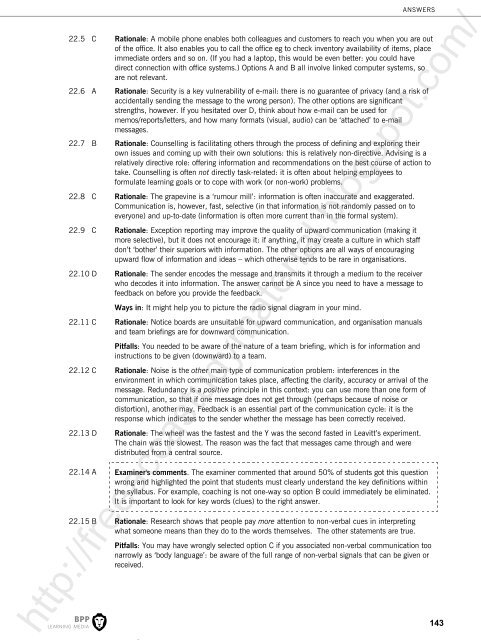FIA ACCA
Create successful ePaper yourself
Turn your PDF publications into a flip-book with our unique Google optimized e-Paper software.
ANSWERS<br />
22.5 C Rationale: A mobile phone enables both colleagues and customers to reach you when you are out<br />
of the office. It also enables you to call the office eg to check inventory availability of items, place<br />
immediate orders and so on. (If you had a laptop, this would be even better: you could have<br />
direct connection with office systems.) Options A and B all involve linked computer systems, so<br />
are not relevant.<br />
22.6 A Rationale: Security is a key vulnerability of e-mail: there is no guarantee of privacy (and a risk of<br />
accidentally sending the message to the wrong person). The other options are significant<br />
strengths, however. If you hesitated over D, think about how e-mail can be used for<br />
memos/reports/letters, and how many formats (visual, audio) can be ‘attached’ to e-mail<br />
messages.<br />
22.7 B Rationale: Counselling is facilitating others through the process of defining and exploring their<br />
own issues and coming up with their own solutions: this is relatively non-directive. Advising is a<br />
relatively directive role: offering information and recommendations on the best course of action to<br />
take. Counselling is often not directly task-related: it is often about helping employees to<br />
formulate learning goals or to cope with work (or non-work) problems.<br />
22.8 C Rationale: The grapevine is a ‘rumour mill’: information is often inaccurate and exaggerated.<br />
Communication is, however, fast, selective (in that information is not randomly passed on to<br />
everyone) and up-to-date (information is often more current than in the formal system).<br />
22.9 C Rationale: Exception reporting may improve the quality of upward communication (making it<br />
more selective), but it does not encourage it: if anything, it may create a culture in which staff<br />
don’t ‘bother’ their superiors with information. The other options are all ways of encouraging<br />
upward flow of information and ideas – which otherwise tends to be rare in organisations.<br />
22.10 D Rationale: The sender encodes the message and transmits it through a medium to the receiver<br />
who decodes it into information. The answer cannot be A since you need to have a message to<br />
feedback on before you provide the feedback.<br />
Ways in: It might help you to picture the radio signal diagram in your mind.<br />
22.11 C Rationale: Notice boards are unsuitable for upward communication, and organisation manuals<br />
and team briefings are for downward communication.<br />
Pitfalls: You needed to be aware of the nature of a team briefing, which is for information and<br />
instructions to be given (downward) to a team.<br />
22.12 C Rationale: Noise is the other main type of communication problem: interferences in the<br />
environment in which communication takes place, affecting the clarity, accuracy or arrival of the<br />
message. Redundancy is a positive principle in this context: you can use more than one form of<br />
communication, so that if one message does not get through (perhaps because of noise or<br />
distortion), another may. Feedback is an essential part of the communication cycle: it is the<br />
response which indicates to the sender whether the message has been correctly received.<br />
22.13 D Rationale: The wheel was the fastest and the Y was the second fasted in Leavitt’s experiment.<br />
The chain was the slowest. The reason was the fact that messages came through and were<br />
distributed from a central source.<br />
22.14 A<br />
Examiner's comments. The examiner commented that around 50% of students got this question<br />
wrong and highlighted the point that students must clearly understand the key definitions within<br />
the syllabus. For example, coaching is not one-way so option B could immediately be eliminated.<br />
It is important to look for key words (clues) to the right answer.<br />
22.15 B Rationale: Research shows that people pay more attention to non-verbal cues in interpreting<br />
what someone means than they do to the words themselves. The other statements are true.<br />
Pitfalls: You may have wrongly selected option C if you associated non-verbal communication too<br />
narrowly as ‘body language’: be aware of the full range of non-verbal signals that can be given or<br />
received.<br />
http://freeaccastudymaterial.blogspot.com/<br />
143





